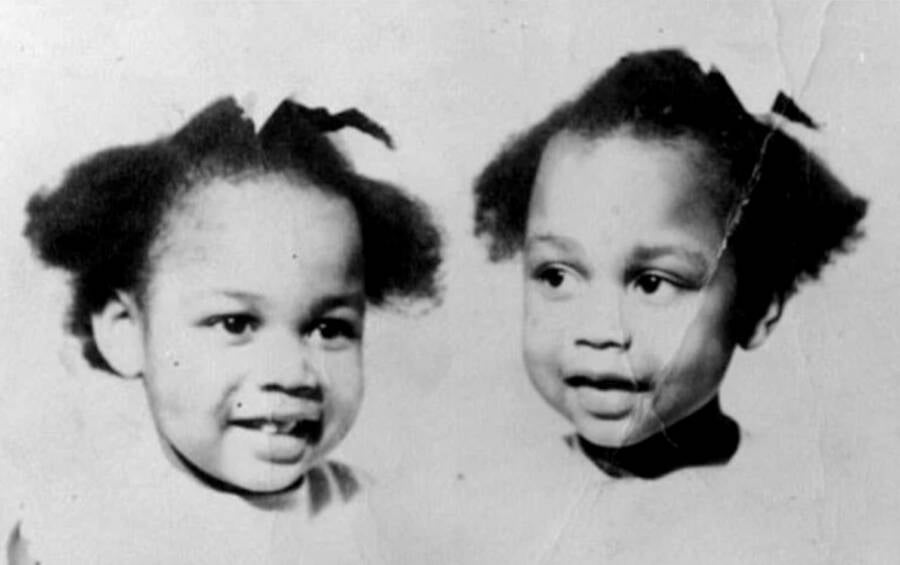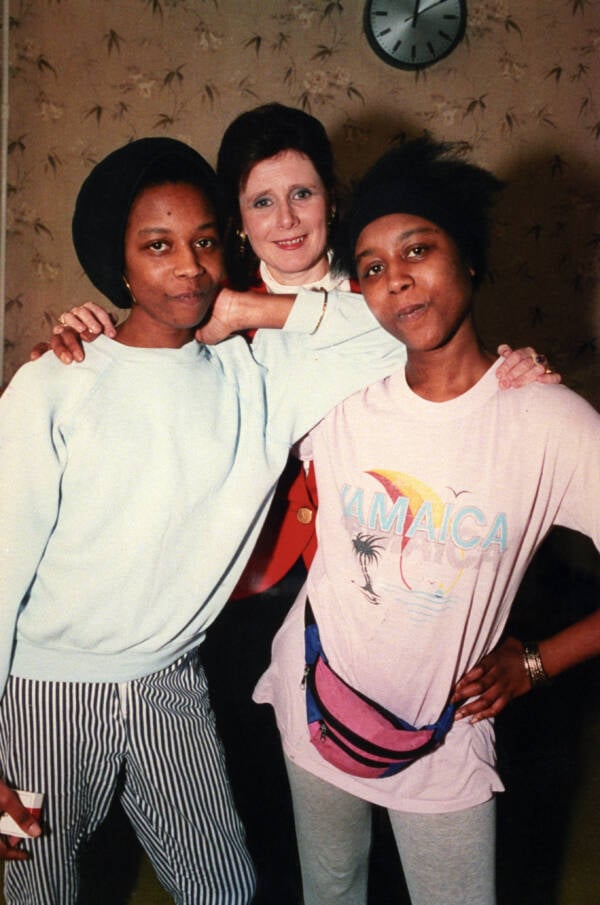"Silent twins" June and Jennifer Gibbons spoke only to each other, used their own special language, and mirrored each other's behavior for three decades straight.

YouTube“Silent twins” June and Jennifer Gibbons developed their own language because their speech impediment prevented others from understanding them.
In April 1963, a pair of twin girls were born at the military hospital in Aden, Yemen. Their births were not unusual, nor were their dispositions as infants, but soon enough, their parents began to see that June and Jennifer Gibbons were not like other kids.
Raised in Wales by their Barbadian immigrant parents, June Gibbons and Jennifer Gibbons soon retreated into their own private world. Due to a speech impediment, it was hard for others, even their parents, to understand them, and eventually, they developed a special language that was just theirs. They so seldom spoke to anyone else that they became known as the “silent twins” — and it wouldn’t be until one of the twins met her untimely death in 1993 that any sense of normalcy would be reclaimed.
This is the story of June and Jennifer Gibbons, the silent twins.
The Unusual Childhood Of June And Jennifer Gibbons
Not long after their girls hit speaking age, Gloria and Aubrey Gibbons realized that their twin daughters were different. Not only were they far behind their peers in regard to language skills, but they were also unusually inseparable, and the two girls seemed to have a private language that only they could understand.
“In the home, they’d talk, make sounds, and all that, but we knew that they weren’t quite like, you know, normal children, talking readily,” their father Aubrey recalled.
The Gibbons family was originally from Barbados and had immigrated to Great Britain in the early 1960s. Though the family spoke English at home, young June and Jennifer Gibbons began to speak another language, believed to be a sped-up version of Bajan Creole. The two would come to be known as the “silent twins” for their unwillingness to communicate with anyone except for each other.

YouTubeThe “silent twins” June and Jennifer Gibbons in elementary school.
It wasn’t only a singular dialect that kept the girls isolated. Being the only Black children in their elementary school made them the target of bullying, which only deepened their dependency on each other. As the bullying got worse, school officials began releasing the girls early, in the hopes that they could sneak out and avoid being harassed.
By the time June and Jennifer Gibbons were teenagers, their language had become unintelligible to anyone else. They had also developed other peculiarities, such as refusing to communicate with virtually any outsiders, refusing to read or write in school, and mirroring each other’s actions.
Years later, June summarized the dynamic with her sister as such: “One day, she’d wake up and be me, and one day I would wake up and be her. And we used to say to each other, ‘Give me back myself. If you give me back myself I’ll give you back yourself.'”
Others Begin To Notice The Strange Behavior Of “The Silent Twins”
In 1974, a medic named John Rees noticed the girls’ strange behavior while administering a yearly school-sanctioned health check. According to Rees, the twins were unusually non-reactive to being vaccinated. He described June and Jennifer Gibbons’ behavior as “doll-like” and quickly alerted the school’s headmaster.
When the headmaster brushed him off, noting that the girls were not “especially troubled,” Rees notified a child psychologist, who immediately insisted that the girls be enrolled in therapy. However, despite seeing several psychotherapists, psychiatrists, and psychologists, the “silent twins” remained a mystery, and continued to refuse to speak to anyone else.
In February of 1977, a speech therapist, Ann Treharne, met with the two girls. While refusing to speak in Treharne’s presence, the two consented to having their dialogues recorded if left alone.
Treharne had the sense that June wished to speak to her but was being compelled not to do so by Jennifer. Treharne later said that Jennifer “sat there with an expressionless gaze, but I felt her power. The thought entered my mind that June was possessed by her twin.”
Ultimately, the decision was made to separate the silent twins and send June and Jennifer Gibbons to two different boarding schools. The hope was that, once they were on their own and able to develop a sense of self, the girls would break out of their shells and begin to communicate with the wider world.
It was immediately clear that the experiment was a failure.
Rather than branch out, June and Jennifer Gibbons withdrew entirely into themselves and became almost catatonic. At one point during their separation, it took two people to get June out of bed, after which she was simply propped against a wall, her body “stiff and heavy as a corpse.”
The Dark Side Of June And Jennifer Gibbons’ Life As The Silent Twins

Getty ImagesJune and Jennifer Gibbons with journalist Marjorie Wallace in 1993.
Upon being reunited, the silent twins hewed even more tightly to one another and became more withdrawn from the rest of the world. They no longer spoke to their parents, except for communicating by writing letters.
Retreating to their bedroom, June and Jennifer Gibbons spent their time playing with dolls and creating elaborate fantasies that they would sometimes record and share with their younger sister Rose — by this time, the only recipient of communication in the family. In a 2000 interview, June said:
“We had a ritual. We’d kneel down by the bed and ask God to forgive our sins. We’d open the Bible and start chanting from it and pray like mad. We’d pray to Him not to let us hurt our family by ignoring them, to give us strength to talk to our mother, our father. We couldn’t do it. Hard it was. Too hard.”
After being gifted a pair of diaries for Christmas, the silent twins began writing their plays and fantasies down, and developed a passion for creative writing. When they were 16 years old, the twins took a mail-order writing course, and began pooling together their small financial assets to publish their stories.
While the story of two young women who shun the outside world and retreat together to focus on writing sounds like the perfect situation for crafting the next great novel, this proved not to be the case for the silent twins. The themes of their self-published novel were as strange and worrisome as their behavior.
Most of the stories took place in the United States — specifically Malibu — and centered around young, attractive people who committed grisly crimes. While only one novel — titled The Pepsi-Cola Addict, about a young teenager seduced by his high school teacher — made it to print, that didn’t stop June and Jennifer Gibbons from penning a dozen other tales.
After the printing of their book, the silent twins became bored with simply writing about life outside their bedroom walls, and longed to experience the world firsthand. By the time they were 18, June and Jennifer Gibbons had started experimenting with drugs and alcohol and began committing petty crimes.
Eventually, these crimes escalated to arson and they were arrested in 1981. Soon after, they were placed in a maximum-security hospital for the criminally insane.
The Silent Twins’ Hospitalization Ultimately Ends In Jennifer Gibbons’ Death
Being hospitalized at Broadmoor Hospital did not prove easy for June and Jennifer Gibbons.
The high-security mental health facility was not as lenient about the girls’ lifestyle as their school and family had been. Instead of letting them retreat into their own world, the doctors at Broadmoor began treating the silent twins with high doses of antipsychotic medicines, which caused blurred vision for Jennifer.
For nearly 12 years, the girls lived at the hospital, and their only respite was found in filling page after page in diary after diary. June later summarized their stay at Broadmoor:
“We got twelve years of hell, because we didn’t speak. We had to work hard to get out. We went to the doctor. We said, ‘Look, they wanted us to talk, we’re talking now.’ He said, ‘You’re not getting out. You’re going to be here for thirty years.’ We lost hope, really. I wrote a letter to the Home Office. I wrote a letter to the Queen, asking her to pardon us, to get us out. But we were trapped.”
Finally, in March of 1993, arrangements were made for June and Jennifer Gibbons to be transferred to a lower-security clinic in Wales. But upon arrival at the new facility, doctors found that Jennifer was unresponsive. She had seemingly drifted off during the trip and wouldn’t wake up.
After being taken to a nearby hospital, Jennifer Gibbons was pronounced dead due to a sudden inflammation of the heart. She was just 29 years old.
While Jennifer’s untimely death was certainly shocking, so was the effect that it had on June: She suddenly began speaking to everyone as if she had been doing so her whole life.
June Gibbons was released from the hospital shortly after, and by all accounts began living a fairly normal life. It seemed that once the two silent twins were reduced to one, June had no more desire to stay silent.
How The Story Of June And Jennifer Gibbons Came To Public Attention

Getty ImagesJune and Jennifer Gibbons in Broadmoor, during a visit with Marjorie Wallace in January 1993.
If June and Jennifer Gibbons remained the “silent twins” for their entire life together, how does the public know so much about the inner workings of their life? It’s all thanks to a woman named Marjorie Wallace.
In the early 1980s, Marjorie Wallace was working as an investigative journalist with The Sunday Times in London. When she heard about a pair of unusual twin girls responsible for setting at least three fires, she was hooked.
Wallace reached out to the Gibbons family. Aubrey and his wife Gloria allowed Wallace into their home, and into the room where June and Jennifer built their own world.
In a 2015 interview, Wallace recalled her fascination with the imaginative writings she discovered in that room:
“I saw their parents and then they took me upstairs, and they showed me in the bedroom lots of bean bags filled with writings – exercise books. And what I discovered was that while they had been in that room alone, they had been teaching themselves to write. And I put [the books] in the boot of the car and took them home. And I couldn’t believe this, that these girls, to the outside world, hadn’t spoken and had been dismissed as being zombies, had this rich imaginative life.”
Spurred on by her fascination with the silent twins’ minds, Wallace visited June and Jennifer Gibbons in prison while they were still awaiting trial. To her delight, the girls slowly began to speak to her.
Wallace believed that her curiosity of the girls’ writings — and a little determination — could unlock their silence.
“They desperately wanted to be recognized and famous through their writings, to have them published and to have their story told,” Wallace recalled. “And I thought that maybe one way of freeing them, liberating them, would be to unlock them from that silence.”
Though June and Jennifer Gibbons were ultimately taken to Broadmoor, Wallace never gave up on them. During their silent stint in the mental institution, Wallace continued to visit and coax words out of them. And, little by little, she made her way into their world.
“I always liked being with them,” she said. “They would have that wry little sense of humor. They would respond to jokes. Often we would spend our teas together just laughing.”

Public DomainMarjorie Wallace brought the silent twins out of their shells and researched them throughout their time at Broadmoor.
But underneath the laughter, Wallace began to discover a darkness within each twin. Reading through June’s diaries, she found that June felt possessed by her sister, whom she referred to as a “dark shadow” over her. Meanwhile, Jennifer’s diaries revealed that she thought of June and herself as “fatal enemies,” and described her sister as “a face of misery, deception, murder.”
Wallace’s research into June and Jennifer Gibbons’ earlier diaries revealed a deep-rooted disdain for one another. Despite the silent twins’ seemingly unshakeable bond, and their apparent devotion to each other, the girls had each privately recorded increasing fear of the other for over a decade.
For the most part, Wallace noticed, June seemed to be more fearful of Jennifer, and Jennifer seemed to be the dominant force. In the early stages of their relationship, Wallace continuously noted that June seemed to want to speak to her, but subtle clues from Jennifer seemed to stop June.
As time went on, that attitude appeared to continue. Throughout her relationship with the silent twins, Wallace would note June’s apparent wish to distance herself from Jennifer, and Jennifer’s domineering ways.
The Hidden Story Behind Jennifer Gibbons’ Death
After Jennifer Gibbons’ death in 1993, Marjorie Wallace offered some shocking revelations. In the days before their move, Wallace visited June and Jennifer Gibbons at Broadmoor, as she did every weekend. In an interview with NPR, Wallace later recalled the moment she knew something was wrong:
“I took my daughter in, and we went through all the doors and then we went into the place where the visitors were allowed to have tea. And we had quite a jolly conversation to begin with. And then suddenly, in the middle of the conversation, Jennifer said, ‘Marjorie, Marjorie, I’m going to have to die,’ and I sort of laughed. I sort of said, ‘What? Don’t be silly… You know, you’re just about to be freed from Broadmoor. Why are you going to have to die? You’re not ill.’ And she said, ‘Because we’ve decided.’ At that point, I got very, very frightened because I could see that they meant it.”
And, indeed, they had. Wallace realized that day that the girls had been preparing for one of them to die for quite some time. It seemed that the silent twins had come to the conclusion that one had to die so the other could truly live.
Of course, following her strange visit with the girls, Wallace alerted their doctors to the conversation they had shared. The doctors told her not to worry, and said that June and Jennifer Gibbons were under supervision.
But the morning that the girls left Broadmoor, Jennifer reported not feeling well. As they watched the gates of Broadmoor close from within their transport car, Jennifer rested her head on June’s shoulder and said, “At long last we’re out.” She then slipped into some sort of coma. Less than 12 hours later, she was dead.
It wasn’t until they reached Wales that any doctor intervened, and by then it was too late. At 6:15 that evening, Jennifer Gibbons was pronounced dead.

June Gibbons“Silent twins” June Gibbons and Jennifer Gibbons remained close until the latter’s death in 1993.
While the official cause of death was believed to be the major swelling around her heart, Jennifer Gibbons’ death still largely remains a mystery. There was no evidence of poison in her system or anything else unusual.
The doctors at the Caswell Clinic deduced that the medications given to June and Jennifer Gibbons at Broadmoor must have provoked Jennifer’s immune system — though they also noted that June was given the same medications and was in perfect health upon arriving.
After her sister’s death, June wrote in her diary, “Today my beloved twin sister Jennifer died. She is dead. Her heart stopped beating. She will never recognize me. Mom and Dad came to see her body. I kissed her stone-coloured face. I went hysterical with grief.”
But Wallace recalled visiting June several days after Jennifer’s death, and finding her in good spirits and willing to talk — really sit and talk — for the very first time. From that moment on, it seemed June was a new person.
June Gibbons’ Life After The Silent Twins Were No More
June Gibbons told Marjorie how Jennifer’s death had opened her up and allowed her to be free for the first time. She told her how Jennifer had to die, and how they had decided that once she did, it would be June’s responsibility to live for the other.
And June Gibbons did just that. Years later, she still lives in the U.K., not far from her family. She’s rejoined society, and speaks to anyone who will listen — a stark contrast from the girl who spent the beginning of her life talking to no one but her sister.
When asked why she and her sister had committed themselves to being silent for nearly 30 years of their lives, June simply replied, “We made a pact. We said we weren’t going to speak to anybody. We stopped talking altogether — only us two, in our bedroom upstairs.”
After reading the perplexing story of June and Jennifer Gibbons, the silent twins, meet the twins who were separated at birth but led identical lives. Then, read about Abby and Brittany Hensel, a pair of conjoined twins.





